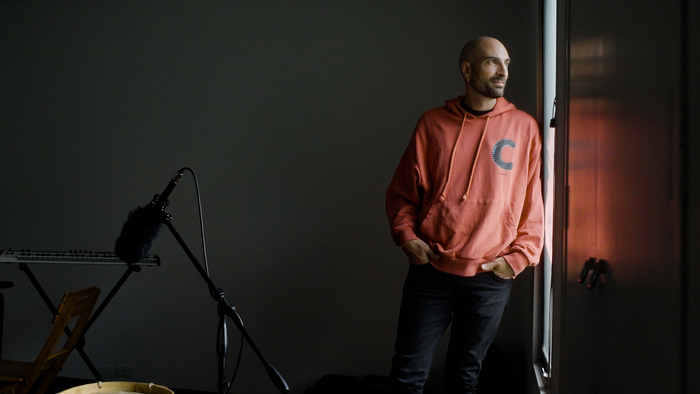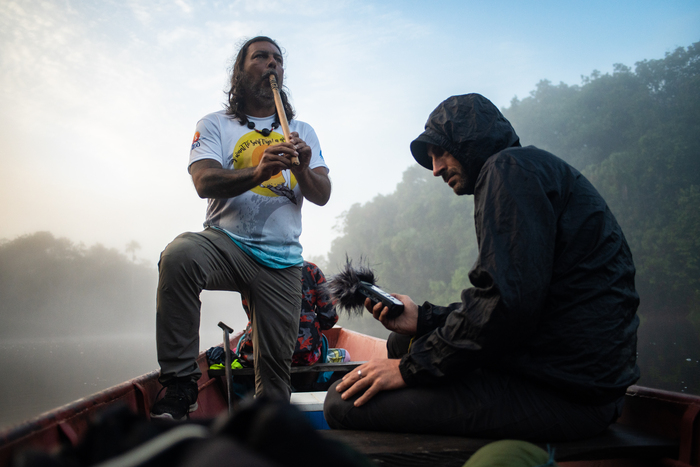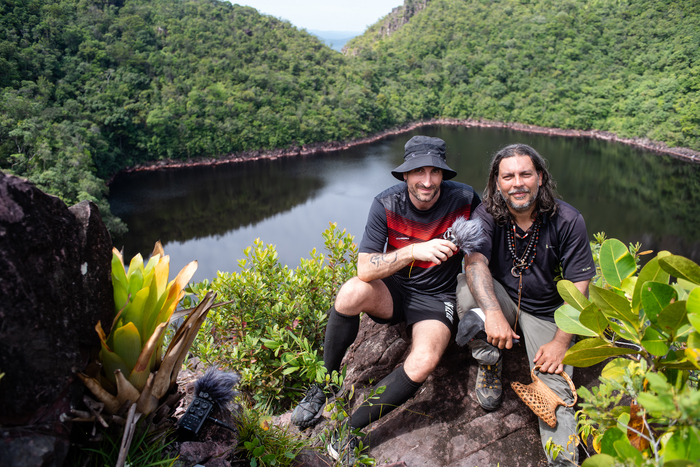Go Dugong ha pubblicato l’8 novembre il suo ultimo album, “MADRE“, in collaborazione con il musicista e ricercatore venezuelano Washé. Ecco la nostra intervista.
Go Dugong, pseudonimo di Giulio Fonseca, ha sviluppato, in questi ultimi dieci anni, uno stile unico e riconoscibile che fonde ritmi globali, field recordings e una vasta gamma di strumenti etnici, animato da una profonda curiosità per le culture sonore del mondo. Le sue produzioni rivelano un lavoro meticoloso, attento ai dettagli e sempre proiettato verso nuove ispirazioni. “MADRE” rappresenta la piena espressione dell’evoluzione artistica di Go Dugong, un album realizzato in collaborazione con il musicista e ricercatore venezuelano Washé e pubblicato l’8 novembre per 42 Records / La Tempesta.
L’incontro tra Go Dugong e Washé avviene a Caracas nel 2022 e segna l’inizio di un percorso che permette ai due artisti di esplorare insieme il potere della musica come linguaggio universale. Entrambi attratti dai suoni ancestrali e dai rituali sciamanici, intraprendono un viaggio nell’Amazzonia venezuelana, immergendosi in una riflessione profonda sul legame tra uomo e natura. Abbiamo incontrato Giulio, che ci ha svelato alcuni aspetti inediti del suo viaggio e del progetto MADRE.

Ciao Giulio, benvenuto su Parkett. Venendo anch’io dalla provincia di Taranto, conosco bene le sfide di vivere in un contesto come quello vicino all’Ilva. Dato che l’arte di Go Dugong è così legata alla terra e le tradizioni, hai mai sentito il bisogno di esprimere in musica uno slancio politico o di protesta rispetto alle difficoltà di crescere in un ambiente come Taranto?
Non saprei dire se la mia musica sia così collegata alla mia terra d’origine. La vedo più legata alle tradizioni del mondo, tra cui anche quelle della mia terra. Lo spettro è molto più ampio. Per rispondere: ogni slancio politico o di protesta ha un suo grado di coinvolgimento e intensità.
Quando è uscito “TRNT” nel 2019 ho fatto un pezzo che si intitola ILVA e l’ho composto pensando al fumo denso che fuoriesce dagli altiforni, al cielo violaceo per l’inquinamento, alle luci inquietanti dell’acciaieria al buio, alla natura circostante che si ammala e all’uomo che si uccide con le sue stesse mani. Ho avuto modo di parlarne quando è uscito quell’EP, riferendomi anche ai danni e la sofferenza causata dal colosso dell’acciaio. Se intendi questo, credo in qualche modo di averlo fatto. Anche “MADRE” lo vedo un disco molto “politico”.
Collaborando con Washé, hai notato possibili similitudini tra il folklore della Puglia e alcuni tratti di quello sudamericano, particolarmente vasto e diversificato? Ci sono elementi che ti hanno particolarmente sorpreso?
Il “folklore sudamericano” è un universo così vasto che non basterebbero 10 vite per conoscerlo tutto, quindi non posso rispondere con certezza. Washé basa la sua ricerca sugli strumenti della tradizione indigena venezuelana, che già da sola è un mondo. In Venezuela ci sono oltre 50 gruppi indigeni, ognuno con il proprio idioma, tradizioni e rituali. Nel disco ha usato strumenti Wayuu, Uwotjuja, Jiwi e Ye’kwana.
Non ho trovato similitudini con il folklore pugliese, ma con quello di altre regioni sì. Mi ha stupito lo strumento “trompa” dei Wayuu, simile al marranzano siciliano. Anche molti strumenti a fiato, come la Sawawa (che si sente nel brano Caos Armónico), assomigliano a quelli della musica folk italiana, come la ciaramella e le launeddas sarde.

Werner Herzog, che citi in press release, dice che “gli uccelli non cantano, urlano di dolore”, e riflette sull’essenza della natura e sull’eterna lotta per la sopravvivenza. Come si riflette questo concetto di amore e lotta con la natura nella vostra musica?
Se ci fai caso, nell’album ci sono momenti diversi. Alcuni sono estremamente dissonanti, ma poi sembrano ritrovare un’armonia. Selva, ad esempio, è una natura che urla, in continuo movimento, un intreccio di vita e morte. È un Caos Armónico riflesso anche nel flauto dissonante e acuto di Agua o in altri momenti del disco.
La vostra musica sembra voler colmare il divario tra l’essere umano moderno e la natura. Che tipo di connessione sperate di creare tra l’ascoltatore e la natura attraverso “MADRE”? Qual è il messaggio principale che volete trasmettere?
Il messaggio principale è che dobbiamo essere più consapevoli del fatto che ciò che siamo diventati, plasmati dalla società capitalista, non è in armonia con la natura e le altre forme di vita. Questo è un problema, perché danneggia anche noi stessi, che viviamo come automi in un mondo artificiale e antropizzato. È uno stile di vita malsano e la dimostrazione è che tante persone non stanno bene, soffrono di qualche patologia mentale o fisica.
Vorrei che fossimo consapevoli di contare poco su questo pianeta e che la nostra estinzione, al contrario di quella di altre creature, favorirebbe la sua sopravvivenza. So che sono parole forti, ma è così. Madre natura ci dà ossigeno, acqua e cibo sano, e noi la ringraziamo riempiendola di immondizia in nome del progresso tecnologico e del denaro, che a poco servirà quando non rimarrà più nulla. Una volta acquisita questa consapevolezza, forse ci sarà un cambio di rotta. Speriamo di essere ancora in tempo.
“Selva” è un pezzo energico, crudo, rough, ed è dedicato alla Foresta Amazzonica. Ci racconteresti la tua esperienza lì e come questo luogo così peculiare e suggestivo ha influenzato il percorso artistico di Go Dugong e quello personale di Giulio?
Racconto sempre che siamo andati in Amazzonia per la musica, ma una volta lì la musica è passata un po’ in secondo piano. La selva è molto potente, forse il luogo dove ho avvertito maggiormente energie a me fino a quel momento sconosciute.
All’inizio è stato molto provante fisicamente, perché quel posto non è fatto per noi. Dopo giorni a vivere e dormire (per terra, in tenda o su un’amaca), esposti all’ambiente, alle punture d’insetti, lavandoci nel fiume e imparando a essere vigili e attenti a dove mettere i piedi, qualcosa cambia sia nell’anima che nel corpo. Almeno questo è successo a me.
Mi sono sentito più forte giorno dopo giorno e spiritualmente “non valere niente”, inutile in quell’ecosistema, a differenza delle altre forme di vita intorno a me. Ho osservato le comunità indigene che ci hanno ospitato, vedendo in loro armonia e simbiosi con la foresta, la loro casa. E loro ne sono i guardiani.
Ho ringraziato l’universo per la loro esistenza e capito che c’è stata una netta separazione tra noi e la natura, non parlo dei parchi cittadini. Questa separazione, concepita inizialmente per proteggerci – è paradossale che abbiamo paura di essere morsi da un serpente ma ci sterminiamo tra di noi in nome di una religione, di confini o del petrolio – è sfuggita di mano creando una distanza nociva per noi e per il pianeta.
Nella selva, tutti abbiamo avuto il nostro momento di dissoluzione dell’ego. Il mio è stato sulla canoa al buio, sotto un cielo stellato. Mi sono sentito schiacciato dall’universo e il mio spirito si è dissolto nell’immensità. Ho pianto, travolto da un mix di emozioni inspiegabili che non riuscivo a fermare.
Abbiamo cercato di riportare queste sensazioni nell’album, anche se non so se ci siamo riusciti. Spero almeno un po’.
Nel brano “La Gran Danza de Los Animales”, dove l’uso degli strumenti tradizionali è preponderante, anche l’uomo viene inteso come un animale primitivo, nella primordialità del suo spirito?
Certo, l’uomo è un animale primitivo. Rispetto alle altre creature abbiamo in più una coscienza che penso non abbiamo sfruttato sempre nella maniera giusta.
Ma in realtà quel brano è ispirato a valori del Warime, un rituale importante per la gente Huottuja dell’Amazzonia venezuelana. È una celebrazione comunitaria per richiamare gli spiriti ancestrali, mantenere l’equilibrio cosmico e preservare l’identità culturale.
Durante il Warime, le persone si vestono con maschere e abiti tradizionali che rappresentano spiriti animali, piante e forze naturali, incarnando l’interconnessione tra l’essere umano e la natura. È un momento in cui le nuove generazioni imparano dai più anziani, ricevendo valori, miti e conoscenze che garantiscono la continuità della cultura Huottuja.
L’album è diviso in tre fasi: dissonanza, sfida e simbiosi. Il culmine della simbiosi sembra essere raggiunto con “Oda a la Madre”, un brano in cui tutti i pezzi del puzzle sembrano unirsi in maniera armoniosa. È, quindi, come credo suggerisca il titolo, una sorta di dichiarazione d’amore a Madre Natura?
Esattamente. Il disco è il nostro atto di devozione a Madre Natura, un impegno per rendere la nostra esistenza meno gravosa sulle sue spalle.

ENGLISH VERSION
Go Dugong, the pseudonym of Giulio Fonseca, has developed a unique and recognizable style over the past ten years, blending global rhythms, field recordings, and a vast array of ethnic instruments, all driven by a deep curiosity for the world’s sonic cultures. His productions reveal meticulous work, attention to detail, and a constant pursuit of new inspirations. “MADRE“ embodies the culmination of this artistic exploration by Go Dugong, an album created in collaboration with Venezuelan musician and researcher Washé, released on November 8 by 42 Records / La Tempesta.
Go Dugong and Washé first crossed paths in Caracas in 2022, sparking a creative partnership that allowed the two artists to explore the power of music as a universal language. Drawn to ancestral sounds and shamanic rituals, they ventured deep into the Venezuelan Amazon, immersing themselves in a profound reflection on the connection between humans and nature. We spoke with Giulio, who shared new insights from his travels and the MADRE project.

Hi Giulio, welcome to Parkett. Coming from Taranto’s province myself, I understand the challenges of living near the Ilva steel company. Given how connected the art of Go Dugong is to the land and traditions, have you ever felt the need to express political or protest themes in your music, addressing the difficulties of growing up in a place like Taranto?
I’m not sure if my music is that connected to my homeland specifically. I see it more tied to the traditions of the world, which also include my land, but with a much broader spectrum. To answer your question: every political or protest-driven impulse has its degree of involvement and intensity.
When “TRNT” came out in 2019, I made a track called “ILVA”. I composed it with the image of dense smoke billowing from the blast furnaces, the sky turned violet from pollution, the eerie lights of the steel mill at night, the sickened nature around it, and the way humanity harms itself with its own hands. I had the chance to speak about it when that EP was released, referring to the damage and suffering caused by the steel company. If that’s what you mean, then yes, I think I have done that, in a way. I also see MADRE as a very “political” record.
In collaborating with Washé, did you notice any similarities between the folklore of Puglia and certain elements of South American folklore, which is especially vast and diverse? Were there any elements that particularly surprised you?
“South American folklore” is such a vast universe that even ten lives wouldn’t be enough to know it all, so I can’t say for sure. Washè bases his research on the instruments of Venezuela’s indigenous tradition, which alone is an entire world. Venezuela is home to over 50 indigenous groups, each with its own language, traditions, and rituals. On the album, he used Wayuu, Uwotjuja, Jiwi, and Ye’kwana instruments.
I didn’t find similarities with Apulian folklore, but I did see some connections with the folklore of other regions. The Wayuu trompa, for instance, is similar to the Sicilian marranzano. Many wind instruments, like the Sawawa (which you can hear in the track “Caos Armónico”), resemble those in Italian folk music, such as the ciaramella and the Sardinian launeddas.

Werner Herzog, whom you mention in your press release, says, “Birds don’t sing; they scream in pain,” reflecting on the essence of nature and the eternal struggle for survival. How does this idea of love and struggle with nature manifest in your music?
If you listen carefully, there are distinct moments throughout the album. Some parts are extremely dissonant, but then they seem to find a sort of harmony. Selva, for instance, is nature screaming, constantly moving, an interweaving of life and death. It’s a Caos Armónico echoed in the dissonant, piercing flute of Agua and other moments on the album.
Go Dugong and Washé’s music seems to aim to bridge the gap between modern humanity and nature. What kind of connection do you hope to create between the listener and nature through MADRE? What’s the main message you want to convey?
The main message is that we need to become more aware that who we have become, shaped by capitalist society, is not in harmony with nature or other forms of life. This is a problem because it harms us as well — we live like automatons in an artificial, human-centered world. It’s an unhealthy way of life, and the proof is in the number of people suffering from physical or mental health issues.
I’d like us to realize how insignificant we are on this planet and that, unlike the extinction of other creatures, our extinction would likely benefit the planet’s survival. I know these are strong words, but it’s true. Mother Nature gives us oxygen, water, and healthy food, and we thank her by filling her with waste in the name of technological progress and money—which will mean little when there’s nothing left. Perhaps if we gain this awareness, we can change course. Hopefully, there’s still time. 🙂
“Selva is an energetic, raw, rough track, dedicated to the Amazon Rainforest. Could you tell us about your experience there and how this unique and evocative place has influenced Go Dugong’s artistic path as well as Giulio’s personal journey?
I always say that we went to the Amazon for the music, but once there, the music took a bit of a backseat. The rainforest is powerful—perhaps the place where I felt energies previously unknown to me most intensely.
At first, it was physically challenging because that place isn’t made for us. After days of living and sleeping (on the ground, in tents, or hammocks), exposed to the environment, insect bites, washing in the river, and learning to stay vigilant about where to step, something changes in both body and soul — at least, that’s what happened to me.
Day by day, I felt stronger and spiritually humbled, almost insignificant, in that ecosystem, unlike the other life forms around me. I observed the indigenous communities who hosted us, witnessing in them a harmony and symbiosis with the forest, their home, of which they are guardians.
I thanked the universe for their existence and realized that there has been a significant separation between us and nature — and I don’t mean city parks. This separation, initially conceived to protect us, has spiraled out of control, creating a harmful distance for us and the planet.
In the rainforest, we all experienced a kind of ego dissolution. Mine happened on a canoe in the darkness under a star-filled sky. I felt crushed by the universe, and my spirit dissolved into the vastness. I cried, overwhelmed by an inexplicable mix of emotions I couldn’t contain.
We tried to capture these sensations in the album, though I’m not sure if we succeeded. I hope we did, at least a little. 🙂
In the track “La Gran Danza de Los Animales,” where traditional instruments play a dominant role, is humanity seen as a primitive animal, connected to the primality of its spirit?
Absolutely, humanity is a primitive animal. Compared to other creatures, we have consciousness, though I don’t think we’ve always used it wisely.
But actually, that track is inspired by values from Warime, an important ritual for the Huottuja people of the Venezuelan Amazon. It’s a community celebration to summon ancestral spirits, maintain cosmic balance, and preserve cultural identity.
During Warime, people wear traditional masks and costumes representing animal spirits, plants, and natural forces, embodying the interconnectedness of humans and nature. It’s a time when younger generations learn from elders, receiving values, myths, and knowledge that ensure the continuity of the Huottuja culture.
The album is divided into three phases: dissonance, challenge, and symbiosis. The peak of symbiosis seems to be reached with “Oda a la Madre,” a track where all the pieces of the puzzle seem to harmoniously come together. Is it, as the title suggests, a sort of declaration of love to Mother Nature?
Exactly. The album is our act of devotion to Mother Nature, a commitment to making our existence gentler on her shoulders.

